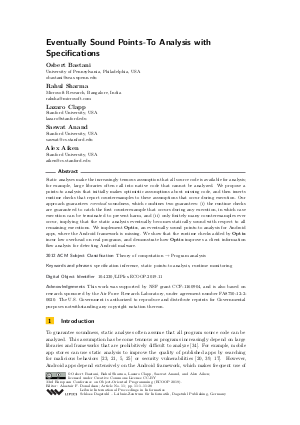@InProceedings{bastani_et_al:LIPIcs.ECOOP.2019.11,
author = {Bastani, Osbert and Sharma, Rahul and Clapp, Lazaro and Anand, Saswat and Aiken, Alex},
title = {{Eventually Sound Points-To Analysis with Specifications}},
booktitle = {33rd European Conference on Object-Oriented Programming (ECOOP 2019)},
pages = {11:1--11:28},
series = {Leibniz International Proceedings in Informatics (LIPIcs)},
ISBN = {978-3-95977-111-5},
ISSN = {1868-8969},
year = {2019},
volume = {134},
editor = {Donaldson, Alastair F.},
publisher = {Schloss Dagstuhl -- Leibniz-Zentrum f{\"u}r Informatik},
address = {Dagstuhl, Germany},
URL = {https://drops.dagstuhl.de/entities/document/10.4230/LIPIcs.ECOOP.2019.11},
URN = {urn:nbn:de:0030-drops-108038},
doi = {10.4230/LIPIcs.ECOOP.2019.11},
annote = {Keywords: specification inference, static points-to analysis, runtime monitoring}
}

 Creative Commons Attribution 3.0 Unported license
Creative Commons Attribution 3.0 Unported license

















































